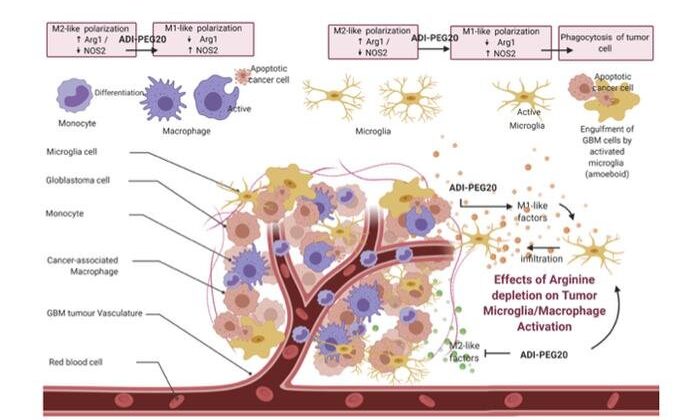
A study recently accepted for publication in the Journal of Clinical Investigation describes a new and effective therapy to treat glioblastoma: the concomitant use of ADI-PEG20 together with focal brain radiotherapy. This double treatment completely eliminated the tumor in the animal models used in the study. This study was carried out by researchers from the Institute of Biomedicine of Seville: Dr. Manuel Sarmiento Soto, Dr. Juan García Revilla, and Dr. José Luis Venero, in collaboration with Dr. Nabil Hajji and Dr. Nel Syed of Imperial College London.
Currently, glioblastoma is a terminal disease whose average life expectancy is less than two years. The treatments used at present are based on therapies that are more than 30 years old as no significant advances have been made to efficiently combat this type of tumor.
The results of this study offer a new therapeutic option against glioblastoma: the use of the drug ADI-PEG20, which eliminates systemic arginine, in combination with the application of focal brain radiotherapy. With this, it was possible to observe how a brain tumor, incurable to date, was completely eliminated in in vivo models that died of natural causes without showing any manifestation of the disease.
“With this new treatment, we were able to cure animals of an aggressive and terminal disease,” says Dr. Sarmiento, “the post-mortem analyses detected how the cerebral immune response, and fundamentally the microglia cells, were activated during the treatment, directing their attack against the tumor cells and thus facilitating the tumor’s complete elimination.”
The data obtained are a ray of hope for the treatment of patients with this type of tumor, since, regardless of the success of the new anticancer drugs, their efficacy in the central nervous system is currently very limited, largely due to their difficulty in reaching the cancer cells located inside the brain.
Worth noting is another clinical trial (NCT04587830) also focused on another specific type of glioblastoma patient, studying the use of the same drug and whose results are proving to be very promising. Importantly, the drug did not manifest side effects in the patients involved in said trial.
Source: Read Full Article
